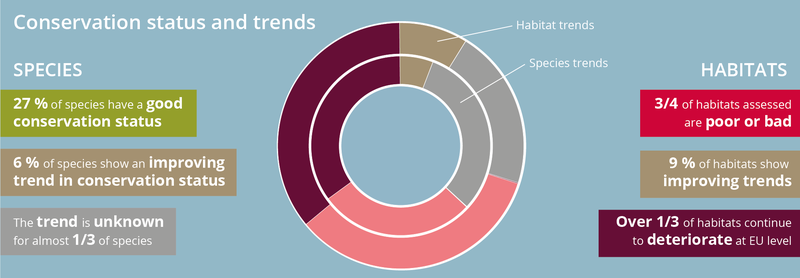All official European Union website addresses are in the europa.eu domain.
See all EU institutions and bodiesDespite some positive results of conservation action in recent years, the latest assessments of habitats and species in Europe show worrying results.
The European Union (EU) protects 1,389 animal and plant species and 233 habitat types. Our latest assessment shows that habitats and species protected under the EU Habitats Directive have a predominantly unfavourable conservation status at 81% for habitats and 63% for species. Only 15% of habitats and around 27% of species have a good conservation status.
81% of habitats and 63% of species have a poor or bad conservation status in Europe.

- 15% of habitats have a good conservation status, with 81% having poor (45%) or bad (36%) conservation status at EU level.
- 9% of habitats, that have an unfavourable conservation status, show improving trends; however, 36% of these habitats show deteriorating trends.
- Forests exhibit the most improving trends. The highest number of deteriorating trends is that for grasslands, dune habitats and bogs, mires and fens.
- Over a quarter of species have a good conservation status, which is an increase of 4% compared with the previous reporting period (2007-2012). Reptiles and vascular plants have the highest proportion of good conservation status.
- While 6% of the species with an unfavourable conservation status show an improving trend, 35% show a deteriorating trend.
Overall, despite some improvements, progress has not been substantial to halt the deterioration in the status of the species and habitats covered by the Habitats Directive. There are also many assessments with unknown conservation status and trends, which reflect the significant gaps in knowledge, especially for marine species and habitats. This indicates that additional efforts will be needed to gather knowledge and reverse the current trends for the benefit of nature, people, climate and the economy.
For the complete analysis on bird populations, see the latest EEA report on the ‘State of nature’
- Explore our data on the state of nature
Background information: What data are collected under the EU Habitats Directive?
The EU Habitats Directive protects European animal and plant species, which are endangered, vulnerable, rare and endemic. The Directive also protects several natural and semi-natural habitat types.
EU Member States report on the conservation status and trends in species and habitats within each biogeographical and marine region every six years. Additionally, such reporting collects comprehensive data on pressures and threats, conservation measures and the role of Natura 2000 sites. This information is then used to assess the implementation of the Directive and the progress in implementing the EU Biodiversity Strategy.
